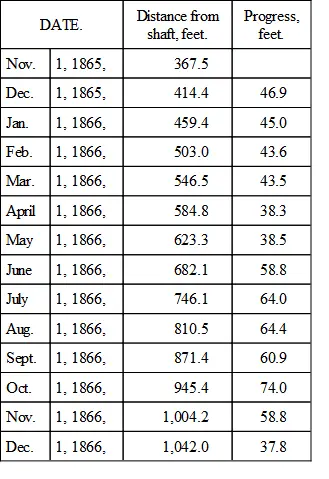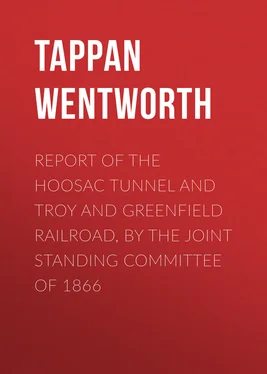Tappan Wentworth - Report of the Hoosac Tunnel and Troy and Greenfield Railroad, by the Joint Standing Committee of 1866
Здесь есть возможность читать онлайн «Tappan Wentworth - Report of the Hoosac Tunnel and Troy and Greenfield Railroad, by the Joint Standing Committee of 1866» — ознакомительный отрывок электронной книги совершенно бесплатно, а после прочтения отрывка купить полную версию. В некоторых случаях можно слушать аудио, скачать через торрент в формате fb2 и присутствует краткое содержание. Жанр: foreign_antique, Технические науки, foreign_edu, на английском языке. Описание произведения, (предисловие) а так же отзывы посетителей доступны на портале библиотеки ЛибКат.
- Название:Report of the Hoosac Tunnel and Troy and Greenfield Railroad, by the Joint Standing Committee of 1866
- Автор:
- Жанр:
- Год:неизвестен
- ISBN:нет данных
- Рейтинг книги:5 / 5. Голосов: 1
-
Избранное:Добавить в избранное
- Отзывы:
-
Ваша оценка:
- 100
- 1
- 2
- 3
- 4
- 5
Report of the Hoosac Tunnel and Troy and Greenfield Railroad, by the Joint Standing Committee of 1866: краткое содержание, описание и аннотация
Предлагаем к чтению аннотацию, описание, краткое содержание или предисловие (зависит от того, что написал сам автор книги «Report of the Hoosac Tunnel and Troy and Greenfield Railroad, by the Joint Standing Committee of 1866»). Если вы не нашли необходимую информацию о книге — напишите в комментариях, мы постараемся отыскать её.
Report of the Hoosac Tunnel and Troy and Greenfield Railroad, by the Joint Standing Committee of 1866 — читать онлайн ознакомительный отрывок
Ниже представлен текст книги, разбитый по страницам. Система сохранения места последней прочитанной страницы, позволяет с удобством читать онлайн бесплатно книгу «Report of the Hoosac Tunnel and Troy and Greenfield Railroad, by the Joint Standing Committee of 1866», без необходимости каждый раз заново искать на чём Вы остановились. Поставьте закладку, и сможете в любой момент перейти на страницу, на которой закончили чтение.
Интервал:
Закладка:
Table showing the progress at West Shaft, East Heading, from November 1, 1865, to December 1, 1866.

The West heading at this shaft was at first driven 6 feet by 11. It has been found advisable to enlarge it to the dimension of 10 feet 6 inches by 15 feet. This work has been performed by contract. The first letting was at the rate of four dollars per cubic yard, the State furnishing the materials used and removing the stone. The contractors at this rate could not pay their expenses. It was raised to six dollars per yard which was found not to pay, and in July the price was advanced to seven dollars and fifty cents. The State pay the men, charging the same to the contractors, and keep their time. Good progress is made and the work is done to the satisfaction of the engineer.
The East heading at this point was being enlarged also by contract, from 6 feet by 15, to 10 1/ 2by 15. The work commenced on the 15th of July, 1866; the price paid is seven dollars per cubic yard; the contractors load their own stone and also that coming from the heading. The State provides the materials used, and hoist the stone to the surface. While the work of the miners at the East heading and of the contractors upon both enlargements was progressing in a very satisfactory mariner, the whole was arrested by an unexpected and somewhat sudden influx of
Water in the Tunnel
On the 27th of November the miners working east from the West Shaft struck a seam running across the stratification of the mountain. Water soon issued from the seam at the rate of twenty-three gallons per minute. On the 29th, the water had risen at the foot of the shaft to two and a half feet above grade, and the work was stopped. The usual speed of the engine working the pump was forty-two revolutions per minute; it was increased to fifty-six, and at that rate it succeeded in preventing any further rise of the water. It became necessary to increase the power of the pumps. The plunger was enlarged from eight to ten inches, and a third lift pump was added. To affect this arrangement the pumps were stopped from 9 o'clock, A. M., December 7th, to 3 1/ 2P. M. on the 8th. At this time the water was four feet and eight inches above grade. On the 12th the water was so much reduced that the miners recommenced work. The next day, at 2 P. M., the water was struck in large quantities, the whole flow from the heading being 100 gallons per minute. On the 14th, the work was again suspended, and unsuccessful attempts made to stop the water by means of wooden plugs driven into the seam. The pumps working with the longest stroke and at increased speed, were just able to keep the water from rising.
On the 19th, at 10.30 A. M., one of the trunnions of the pump-bob broke, and seriously injured the pump gearing and boxes. On the 21st a new trunnion was put in, and the pump was attached to the small hoisting engine, the water now being seven feet above grade. On the 28th, at noon, the breakages being all repaired, the large engine was again attached to the pumps, the water then being nine feet and eight inches above grade. And, on the first day of January, at 4 P. M., the water stood nine feet ten inches above grade at the foot of the shaft. 1 1 At the time of the presentation of this Report, the Committee understood that the water was entirely removed from the shaft and tunnel.
The New Shaft
This shaft is located about 264 feet westerly of the West Shaft. Its dimensions are six feet by thirteen in the clear. The rock to be removed from an area of eight feet by fifteen. The labor is done by contract. The first price was $40 per foot; increased July 1, 1866, to $50 per foot. The State furnishes all the materials for construction, and the power to raise the stone and water from the shaft. The depth of the shaft will be 277 feet when open to grade. On the first day of December, the miners working down had progressed 180 feet, and those working from the tunnel up 45 feet. It was then calculated that the shaft would be excavated in two months. Plans for permanent pumps had been prepared; to furnish the pumps according to the plans, would take several mouths. In the meantime, a temporary pump was to be made at North Adams, under the direction of the engineer.
On the first day of January, about thirty-eight feet of stone remained for excavation in this shaft. The water in the tunnel stopped the work from below, and the work is driven upon one face only at the present time.
There are two small engines at this point, one of fourteen and one of ten horse power. The pumps at this shaft, if constructed agreeably to the design of the engineer, will discharge sixty-five gallons to a stroke and are to be worked by a bull engine. The lift of the water will be eighty feet less than at West Shaft, being discharged about 40 feet below the surface.
The West End
The work at the West End of the tunnel is under contract. Mr. B. N. Farren of Doylestown, Bucks County, Pennsylvania, by an agreement dated May 1, 1866, contracted to put in a stone and brick arch of the dimensions before stated, 26 feet by 26, for the following prices, viz.:—Earth excavation $3.50 per yard; brick masonry, $12 per perch; stone masonry, $6 per perch. Contractor planks the bottom and sides when necessary at $15 per lineal foot. The State furnishes the bricks at $9 per thousand and the timber at $16 per thousand for hemlock, and $18 for spruce and hard-wood. The length of arch contracted for is 174 feet, the whole of which is open. The State also furnishes the cement, which costs in Troy, New York, from $1.65 to $1.70 per barrel, to which is to be added the freight at 30 cents per barrel. A barrel of cement is used for a perch of masonry.
The contractor agrees to construct two hundred feet of under ground tunnel, and as much more as he can before August 1, 1867, at the following prices, viz.:—Earth excavation at $6.50 per yard; brick masonry at $13 per perch; stone masonry at $6.50 per perch. The timbering, from $40 to $50 per foot, lineal, depending upon the thickness of the wall. He may, under permission from the engineer, take stone and sand from the State's premises, without making compensation.
Payments are to be made about the 12th of each month for the work done the preceding month, at the rate of 80 per cent. of the finished work.
The decision of the engineer as to the method, quality, quantity and classification of the work to be final and conclusive. In order to facilitate the progress of the work and with a due regard to economy, the State has purchased the following lots of land in the vicinity of the West End, to wit:—A wood lot, containing sixty acres, at a cost of $9,900; the Harrington Farm; 130 acres with the buildings, inclosing the West End and West Shaft; and running half way up the mountain. This purchase was made January 26, 1866, price $3,000. The Kingsley lot, purchased March 16, 1866, at $2,793.87.
The timber used by Mr. Farren is obtained from these lots. The tops of the trees are cut into wood and used at the brickyard. About five hundred cords of wood has been cut on the Harrington, and one thousand cords on the Kingsley lot, for the use of the brickyard, and is now on hand.
The necessity of making the bricks required for the arch tunnel is apparent. They could not be furnished by individuals at North Adams. 120,000, before the yard at the West End was fitted up, were purchased at Springfield at $9 per thousand; the freight of which to North Adams was $6, and the teaming to the West End $2 per thousand. If to these prices be added the depreciation and waste from handling, the cost will reach $18 for all that could be used in the work. It is the opinion of the engineer and superintendent of labor, that the bricks made by the State will cost less than $9 when delivered to the contractor.
Читать дальшеИнтервал:
Закладка:
Похожие книги на «Report of the Hoosac Tunnel and Troy and Greenfield Railroad, by the Joint Standing Committee of 1866»
Представляем Вашему вниманию похожие книги на «Report of the Hoosac Tunnel and Troy and Greenfield Railroad, by the Joint Standing Committee of 1866» списком для выбора. Мы отобрали схожую по названию и смыслу литературу в надежде предоставить читателям больше вариантов отыскать новые, интересные, ещё непрочитанные произведения.
Обсуждение, отзывы о книге «Report of the Hoosac Tunnel and Troy and Greenfield Railroad, by the Joint Standing Committee of 1866» и просто собственные мнения читателей. Оставьте ваши комментарии, напишите, что Вы думаете о произведении, его смысле или главных героях. Укажите что конкретно понравилось, а что нет, и почему Вы так считаете.












